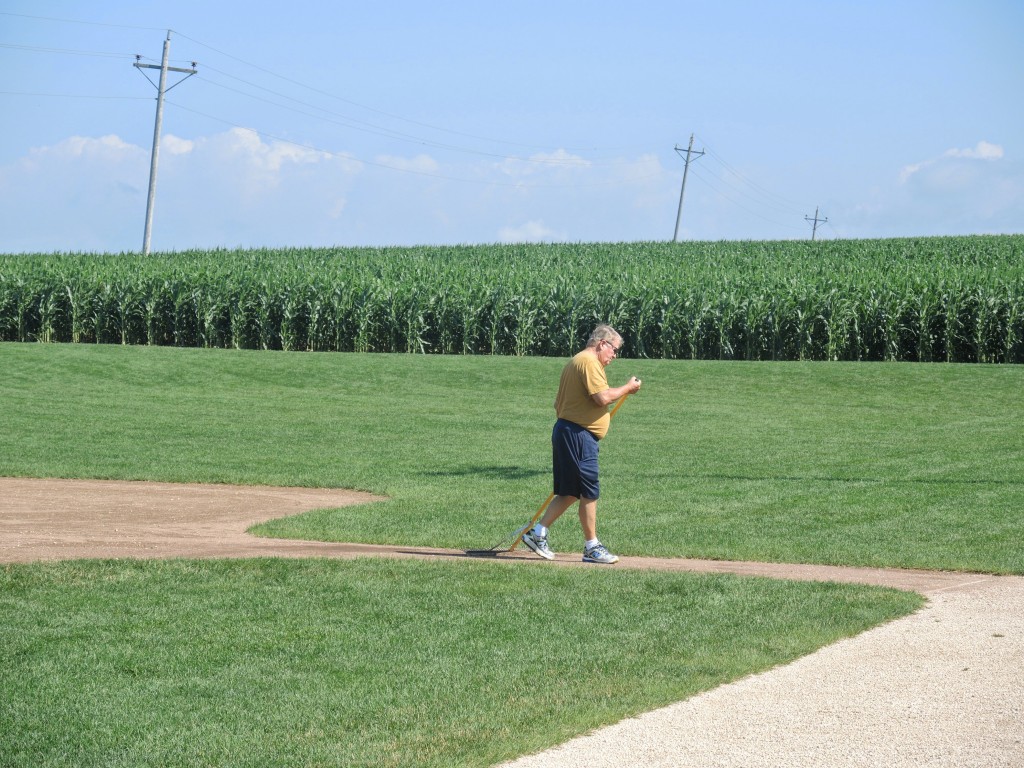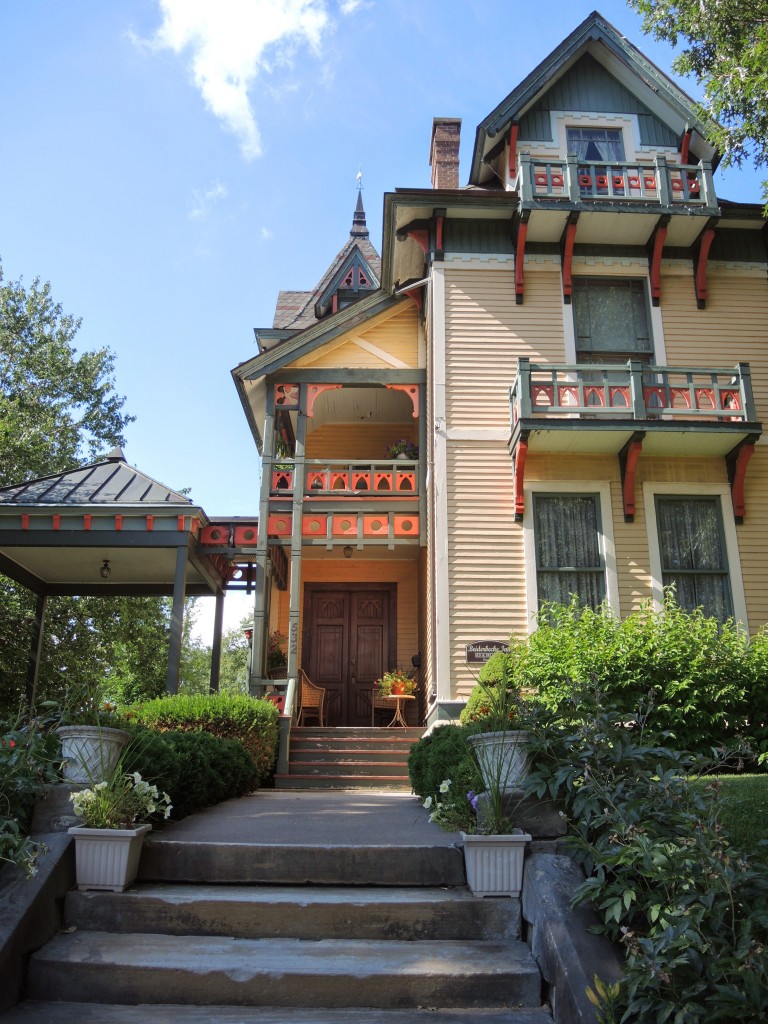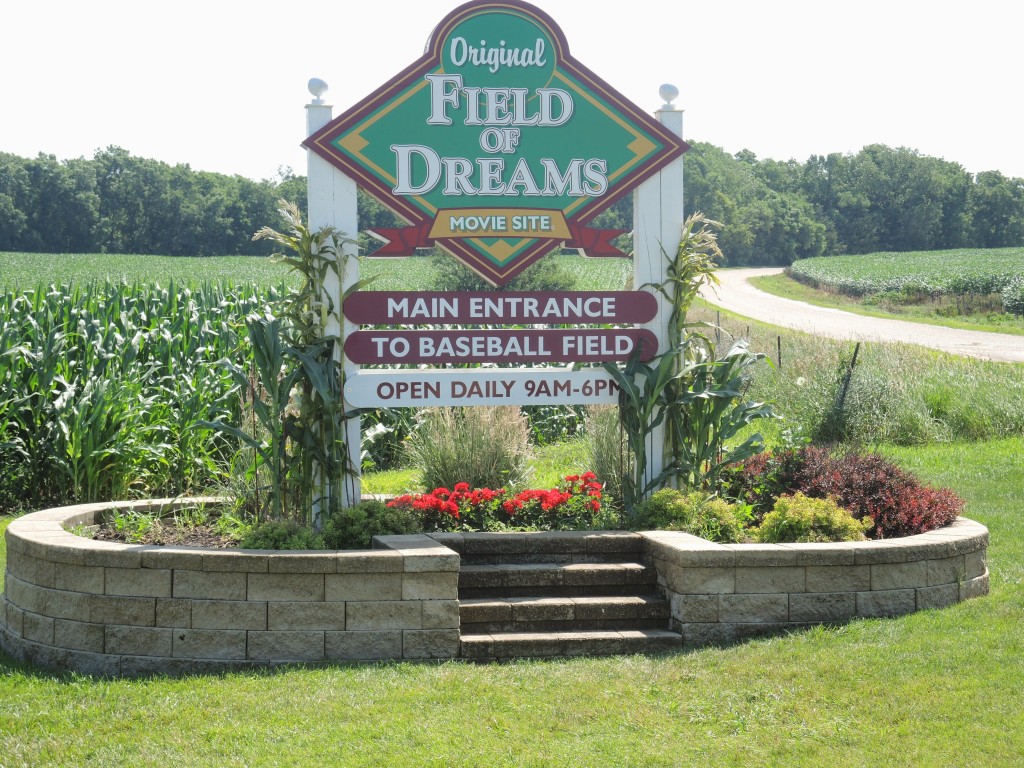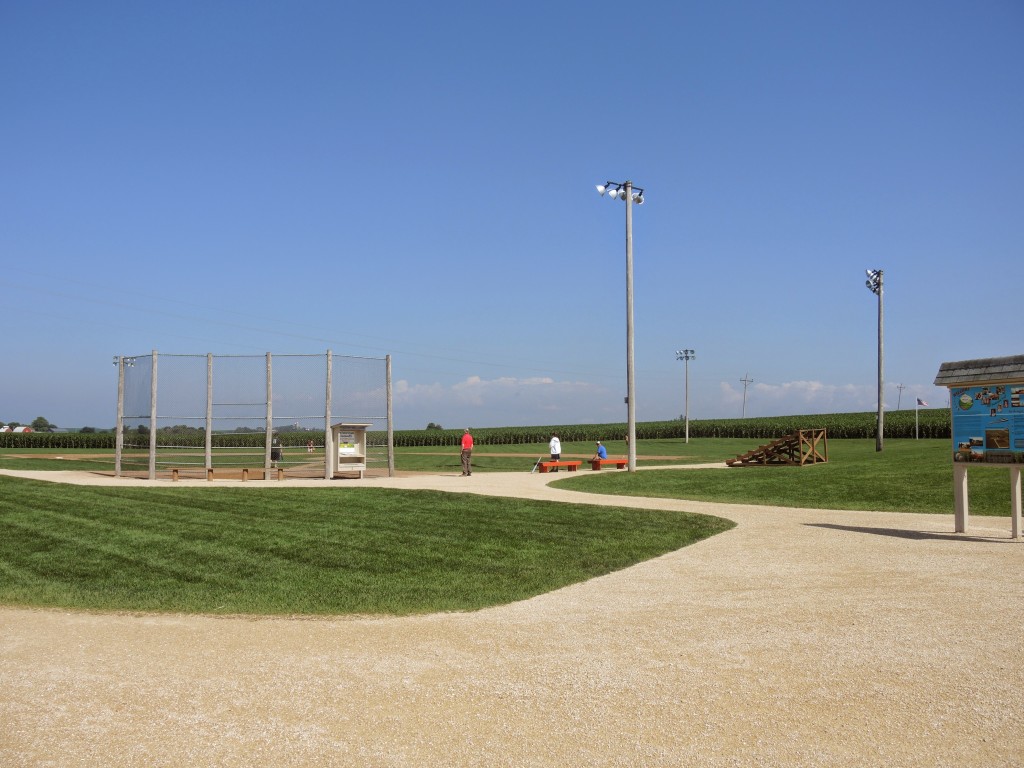About thirty miles west of Dubuque sits the small town of Dyersville. Within that mailing address is the farm that until 2012 belonged to the Lansing family. Set your GPS to Lansing Road and drive until you see this sign:.
Sunday was actually my second trip to the Field of Dreams. I made the first more than a decade ago and, thanks to Don Lansing, the site is little changed. There is, as of this writing, essentially no commercialization of the site. There’s a board that provides some facts about the filming but the only commercial element (if it can be called that) is a small red wood frame shop set discreetly apart from the field and maybe the Pepsi Machine to its right.
However, one of the important changes that occurred since my last visit is that the Lansings purchased the portion of the field (third base line and left field) that once belonged to the Ameskamp family. The Ameskamps did plow under their section of the field in the first year after filming completed but, as visitors continued to come to the site, they (I think reluctantly) agreed to restore it.
Though the Lansings lived in the house until Don sold the property two years ago, the site has never charged any admission. Anyone is free to play on the field, walk around it, run the bases, or simply sit and drink it all in as a spectator. You can, if you’re fortunate enough, even bring your dad and have a catch. One Sunday each month (sadly not this one) throughout the summer, a group of men from the local community don period uniforms and the “ghost team” emerges from the corn.
This visit became all the more special for me when I saw a fellow raking the dirt along the first base line.  Not knowing who it was, I called out to him and asked if he was the official groundskeeper. He turned around and introduced himself. It was Don Lansing. We stood and chatted for 15 or 20 minutes. We talked about the recent 25th anniversary celebration that saw the return of Kevin Costner, Tim Busfield, and other stars of the movie; about the charity game they played; about putting a big screen up in the outfield and having a showing of the film.
Not knowing who it was, I called out to him and asked if he was the official groundskeeper. He turned around and introduced himself. It was Don Lansing. We stood and chatted for 15 or 20 minutes. We talked about the recent 25th anniversary celebration that saw the return of Kevin Costner, Tim Busfield, and other stars of the movie; about the charity game they played; about putting a big screen up in the outfield and having a showing of the film.
I asked him if he’d ever thought of turning the field back into a farm. He told me that he’d been inclined to keep it intact almost from the outset. He said that after the filming wrapped, like Ray Kinsella, he saw something beautiful in the field and thought to leave it intact for at least that first year.
He then told me what really sealed the deal for him. The film was released on 21 April 1989 and the field had its initial visitor the first week in May – a fellow driving from New York to the west coast. Mister Lansing told me that, as it happened in the movie, he had no idea how the man had found the farm. Nothing had been published about the location. No signs existed and he never thought to ask. The man was wearing, of all things, an old New York Giants cap that he gave to Mister Lansing just to thank him for keeping the field. From that point forward, Lansing had little doubt about the field’s fate. He also committed himself to keeping it as simple and as true to what’s seen in the movie as possible.
He added that had the visitors not treated the field respectfully from the outset he might not have maintained it. But everyone did. People come – some 60,000 to 70,000 every year between April and October – they play, they clean up behind themselves even on days when hundreds upon hundreds of people visit. As the morning grew later, the crowd continued to grow larger so this might have turned out to be the case on this particular Sunday. By the time I left I’d estimate 30 to 40 people were present.
Though he still comes out periodically to tend the field, he no longer resides in the house and, as he got older, he felt he had to sell the property. However, with the sale, the field’s future is a bit more uncertain. The purchasers are from Chicago and there is some talk of developing some sort of sports park in the property. So the question now is, “In five years will you be able to visit the field and see just the field, the house, and acres upon acres of corn? Or will it be somewhat intact but with some more permanent stadium somewhere within sight?”
Is Davenport worth a Figge?
Leaving the Field of Dreams, I wanted some time to reflect on life imitating art and drove directly to Davenport. While I avoided the interstate, I also didn’t seek out the G R R so I re-visted Highway 61. In truth, I wanted to get to Davenport to leave sufficient time to explore the Figge Art Museum where I might see art imitating art.
Though it is considered the first municipal art museum in the country, the Figge has been open at its present site for less than a decade. The architecture of this structure is unique. Some consider the Figge to be the principal art museum between Chicago and Denver. It does hold renowned collections of Midwest Regionalist art including works by Grant Wood, Thomas Hart Benton, and John Steuart Curry, one of the largest collections of Haitian art,
Some consider the Figge to be the principal art museum between Chicago and Denver. It does hold renowned collections of Midwest Regionalist art including works by Grant Wood, Thomas Hart Benton, and John Steuart Curry, one of the largest collections of Haitian art,  and perhaps the largest collection of Mexican art outside Mexico City.
and perhaps the largest collection of Mexican art outside Mexico City.
In addition, it presently houses the University of Iowa art collection. It works in conjunction with Iowa and Western Illinois Universities to use the art in educational programs. The main special exhibition at the time of my visit was in fiber art featuring both local and international artists. I joined a tour of this exhibition and had a nice discussion with the docent, Caryl, whose accent betrayed her as being from the east and not native to the Midwest though she told me she’d been living in Iowa for over 30 years.
Although the river has been running high and fast throughout the trip, to date I’ve been upstream from any flooding issues. That changed when I reached Davenport. The fenced area in the photo above is usually open to pedestrians. Also in Davenport, I encountered the first of several partial closures of the G R R. In this instance, though the water had receded, the cleanup wasn’t complete.
when I reached Davenport. The fenced area in the photo above is usually open to pedestrians. Also in Davenport, I encountered the first of several partial closures of the G R R. In this instance, though the water had receded, the cleanup wasn’t complete.
In Davenport, I stayed in the Beiderbecke Inn B&B run by Pam and Dennis LaRoque. To any among you who are fans of jazz from the 1920’s, the name Beiderbecke will instantly ring a bell. Bix Beiderbecke was one of the great trumpet players of that era joining the Paul Whiteman Orchestra in 1928 three years before his untimely death at age 28. You can hear him on coronet about a minute into this performance of Singin’ the Blues with the Frankie Trumbauer Orchestra.
Among other legends that surrounded him, Beiderbecke was immortalized in Dorothy Baker’s novel Young Man With a Horn that later became a movie starring Kirk Douglas, Lauren Bacall, and Doris Day.
Beiderbecke was born and came of age in Davenport. Although he didn’t live in the B & B that bears his family name, he likely spent significant time there since it belonged to his grandparents! I didn’t know this when I chose to stay there but learned it from Pam & Dennis the wonderful innkeepers who provided the best stay of the trip to date. When you arrive, Pam gives you a gift that she has knitted. The dining room is set for you to make coffee or tea at any time and there’s a batch of homemade cookies, too. They fill their home with many pleasant touches like that.
 Before I close this entry, I want to let you all get to know Pam and Dennis a bit better. First, Dennis surprised me as another person with a dash of progressive politics. He pointed me to his favorite op-ed columnist, Leonard Pitts, who from the column or two I’ve read takes an aggressively progressive stand on most issues particularly the ones that involve race relations.
Before I close this entry, I want to let you all get to know Pam and Dennis a bit better. First, Dennis surprised me as another person with a dash of progressive politics. He pointed me to his favorite op-ed columnist, Leonard Pitts, who from the column or two I’ve read takes an aggressively progressive stand on most issues particularly the ones that involve race relations.
But this isn’t the reason I want to write about them. Dennis is an engineer who worked for Alcoa for his entire career. He told me he’s semi-retired because Pam insists he continue working at least a few days per week. They have three children and they adopted their youngest son when he was 18 months old while the LaRoques were living in Texas. At the time, he was considered a hard-to-place child because he was of Mexican and American parentage. As they learned later, he also had a developmental disability but like all good parents, they only talked to me about his abilities. I left Davenport with deep respect for them.
Next up, I return to Illinois and make the trip’s first foray into Missouri.


What a great story about field of dreams, Todd. And the art museum (I love Thomas Hart Benton’s work). Some great images. Thanks…. (Yes, there are progressively political people throughout the mid-west…they are just a semi-endangered group 🙂
And I seemed to find all three of them!
Stunning photos and reporting! You are truly a journalist. Your reportorial skills come through in your travel chronicles, both in the people you meet and your visual intelligence in camera work. You can’t come home! Stay on the road and file stories! I will be sad when your trip is over. *travelling vicariously through Todd*
Thanks. I’ll agree with being a journalist in the sense of keeping a journal. Stylistically, certainly less so.
I always enjoy reading about your travels. The pictures are wonderful.
With more to come.